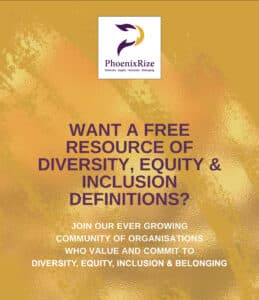When the practice of diversity and inclusion becomes a mere show or a theatrical play in the workplace rather than tangible actions, it creates an environment of disillusioned and devalued employees.
This is the meaning of ‘Diversity Theater’ – The practice of organizations pledging loyal support to diversity, equity and inclusion (“DEI”) initiatives – But ultimately, there are no corresponding numbers, data or experiences to indicate results. This seems to be because of a battle between:
- Company culture – the need to maintain a comfortable status quo that is not ruffled by new controversial positions or drastic changes; and
- The need of the employees in a rapidly evolving external climate.
The conundrum of placing the chicken before the egg rises to the surface in the matter of the relationship between company culture and the interests of marginalized employees. Do the employees’ interests come first, or should the company culture override it? Should a company ‘play’ to the tune of engaging in DEI practices as a way to appear mainstream, while its internal environment has experienced little to no change?
This question is relevant in today’s corporate marketplace, due to the reproofs that have been unfolding against companies, particularly in the technology industry, with regards to the organizations’ internal DEI practices. One of the companies that has received backlash for its avid diversity and inclusion support which does not match the company’s hiring practices, is Facebook.
Facebook recognized this deficiency, based on feedback from its Global Chief Diversity Officer, Maxine Williams, “I know that progress doesn’t always meet the expectations of what people in the world expect we should be able to do if we care, and so I do think that there is a gap there. I like that people have high expectations of us. I have high expectations of us.”
In the meantime, as organizations work towards reconciling their internal policies with the new external realities of diversity and inclusion awareness, a generation of excluded employees continue to walk the hallways of many companies in an ethos that is seemingly playing at diversity and inclusiveness. It has become a situation of difficulty in transitioning into a new organizational mindset which embraces valuing employees and boosting morale with respect to inclusive behavior for a diverse workforce.
What is a ‘Valuable Employee’?
‘Valuable’ or ‘value’ has been ascribed various meanings. It could represent usefulness, worth, merit, deserving of a certain regard, or to be held in esteem.
In the context of diversity, equity and inclusion, there is one word that represents value: Equity. The fair treatment of marginalized groups, in comparison to other groups, is evidence that such an underrepresented group is valued in the workplace.
Equity is often overlooked in the environment of an inclusive workplace that engages a diverse workforce. It is the challenge that rears up in discussions about pay rates, promotions and employment policies.
Equity asks the question: Is the marginalized group experiencing fair treatment?
Fairness Precedes Sameness – Equity Comes Before Equality
If employees are treated fairly, the incidental result that follows is that they will be treated equally.
Therefore, to answer one of the penultimate questions of the day: What is a ‘valuable employee’ in the framework of DEI? They are the people, marginalized or underrepresented, who are now able to enjoy pay raises in comparison to their counterparts because it is only fair to treat them as equally as their colleagues who historically earned higher for the same jobs or roles.
They are the individuals who start to experience promotions because they have equal merits with those of other racial groups, and fairness (the treatment that is impartial and just, and which has to exist before sameness), dictates that they should be treated the same.
They are the employees who have had to put their lives on hold because employment policies do not favor their career progress or development, in comparison to their counterparts who may not be obstructed by such policies. As an example, policies that impact the progress of careers due to maternity leave, effectively stalling the professions of pregnant mothers, has led to unfair effects for the affected group, when compared to their counterparts who do not become impacted by the same policies.
Equity cannot operate without equality. Yet, equity must precede equality. Equity is the impartial judge that will decide that a black woman, a member of a marginalized group, should be considered for the same position as a white man; because she should have a fair opportunity (equity) for a role in which she has the same qualifications (equality) as others.
These governing principles of fairness before sameness, equity before equality, provide the relevant backdrop from which an inclusive environment which engages a diverse workforce can be expected to thrive and excel.
Organizations today can achieve a more seamless transition out of a status quo mindset that pre-dates tolerance for all differences, into a mainstream DEI mentality by:
- engaging the strategies of the healthiest human system; and
- adopting an authentic HR model.
This two-part idea translates into five inclusion strategies.
Strategies 1 to 4: What is the ‘Healthiest Human System’?
The term “Healthiest Human System’ was purportedly coined by former CEO of the global banking giant, HSBC Bank, John Flint. Mr. Flint defined this term as an incorporation of four personal, strategic principles into corporate practices to boost the workplace experience and enable a happier, effective and more productive workforce. The focus of these four concepts is upon the employee, the ‘human system’ that operates any organization, and the building and sustaining of this human system’s health in order to ensure the workplace stays relevant and viable.
Strategy 5: What is an authentic HR model’?
The fifth strategy in the equation towards assimilating into an evolved and improving DEI practice in an organization can be found in the human resources approach to authenticity.
Bringing Together the Two-Part Idea of Inclusion
The combination of these 2-part idea results in the archetypical employee network which has the mental capacity to embrace change with little to no friction. The ultimate outcome is an organization of workers with optimal wellbeing who are able to thrive in an environment which is actively inclusive due to its authentic HR model. A healthily inclusive workplace environment is the only ideal environment that can grow outwardly into a diversity magnet for attracting a diverse workforce; and subsequently, treating them fairly.
Irish businessman, Alan Joyce, lauded the magnetic, inclusive environment, “We have a very diverse environment and a very inclusive culture and those characteristics got us through the tough times. Diversity generated a better strategy, better risk management, better debates, and better outcomes.”
With respect to developing authenticity in HR models, Inga Beale, first female CEO of Lloyds, provided a thought that inspired corporate culture to take forays into the unfamiliar. Beale said: “Many conversations about diversity and inclusion do not happen in the boardroom because people are embarrassed at using unfamiliar words or afraid of saying the wrong thing — yet this is the very place we need to be talking about it. The business case speaks for itself — diverse teams are more innovative and successful in going after new markets.”
Building Inclusiveness and Attracting Diversity
In combining the ideas of the healthy human and authentic HR modeling, the 5 strategies that build and sustain an innovative, inclusive workplace that becomes a diversity magnet which practices equity are:
- Vulnerable leadership: The concept of a leadership team that is susceptible to feedback, reverse mentoring and openness to being viewed at its weakest has not been very popular. There is a belief that it recommends incompetency. On the other hand, a leadership that is vulnerable stands the advantage of being easily forgiven for its mistakes, and gaining the opportunity to advance faster.
- A greater purpose for service: A reason to serve beyond having a career or the economic benefits of a job provides a vigorous drive that maintains employee morale and loyalty.
- Mindfulness for achieving empathy among colleagues: Organizations should make awareness about responsiveness to each human plight as a part of the company culture through training programs.
- Deeper connections through inter-learning and reverse mentoring: Inter-learning and reverse mentoring should not halt at the executive level. Organization-wide practice represents a uniform distribution of vulnerable human connections among employees.
- Development of an authentic HR model: Originality seems lost in HR modeling, particularly in the DEI space. Apart from an HR approach that employs strategies such as HR panels for candidate selection, ideas around practices like role naming should embrace more warmth or trustworthiness. For instance, instead of Equality Manager, a role can have a non-lackluster title such as Equality Champion.
The overall message across organizations is that diversity cannot be achieved without first conquering non-inclusiveness; and non-inclusiveness cannot be conquered without first developing a healthy human system in the workplace; and finally, a healthy human system can exist when people are treated with equity.


